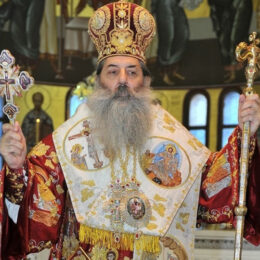 by Andrew M. Greenwell, Esq. –
by Andrew M. Greenwell, Esq. –
The question of capital punishment within the Catholic Church is a thorny one, and it is difficult within the cacophony of competing voices to sort out the current state of the Church’s teaching. The Church’s teaching that relates to the intentional killing of an innocent human being by either public authority or a private actor is certain.The teaching of the Church on the killing of a malefactor-specifically as found in Pope John Paul II’s Evangelium vitae and the editio typica of the Catechism of the Catholic Church-is not quite as absolute. …
The question of capital punishment within the Catholic Church is a thorny one, and it is difficult within the cacophony of competing voices to sort out the current state of the Church’s teaching.
The Church’s teaching that relates to the intentional killing of an innocent human being by either public authority or a private actor is certain. It is an absolute and exceptionless norm that the intentional killing of an innocent human being is in each and every case an intrinsic evil, against the natural moral law, and a violation of the Fifth Commandment. It is a sin against justice and against charity. EV, 57, 62, 65, 71.
The teaching of the Church on the killing of a malefactor-specifically as found in Pope John Paul II’s Evangelium vitae and the editio typica of the Catechism of the Catholic Church-is not quite as absolute, and hence the uncertainty. EV, 57.
Before he was pope, Cardinal Ratzinger himself recognized this in a letter to the U.S. Bishops dated July 3, 2004, where he recognized that “if a Catholic were to be at odds with the Holy Father on the application of capital punishment . . . he would not for that reason be considered unworthy to present himself to Holy Communion.” While urged to “exercise discretion and mercy . . . it may still be permissible . . . to have recourse to capital punishment.”
Without suggesting that I have the final word on the matter which is in a little state of flux and which better minds than mine have struggled, I have tried to do two things in this very short treatment.
First, I have tried to preserve the traditional teaching of the Catholic Church that the death penalty may be justly applied by public authority, i.e., that it is not a moral evil and in fact is a moral good, in a proper case, to put a malefactor to death for a serious capital offense. I believe that teaching to be irreformable. But I have also tried to give John Paul II’s teaching in Evangelium vitae which has found its way into the Catechism of the Catholic Church its full and plenary meaning without quibbling. And taking both teachings, I have attempted to reconcile the two.
The way to I seek to effect a reconciliation between the two is to distinguish between the order of justice and the order of mercy. As St. Ambrose put it in his letter to the Christian judge Studius, “authority, you see, has its rights, but mercy has its policy.”
In Evangelium vitae, with respect to the malefactor and the “problem of the death penalty,” John Paul II is not focusing on the rights of authority in the order of justice to execute a malefactor, but on mercy’s policies. He is balancing two goods: one of justice and one of mercy.
Within the order of justice, for the public authority to put a malefactor guilty of a capital offense to death is no wrong. It is justified by the good of retributive or vindicative justice, and the public authority, as custodian of the common good, has that power given to it by God. It is certainly an evil in the physical order, but it is a moral good in the order of justice.
This is the constant teaching of the Church, and it is found in the Old Testament (e.g., Gen. 9:6, Ex. 21:12; Lev. 24:17), and New Testament (e.g., Rom. 13:1-7), and from St. Clement of Alexandria, to St. Thomas Aquinas, to St. Alphonsus Liguori, the Gratian, to Popes Innocent I and Innocent III to Pius XII. Indeed, I find it to be consistent with John Paul II’s teaching in Evangelium vitae, who observes that while an innocent’s life has absolute value, a malefactor’s life is not likewise so absolute. EV, 57.
However, the order of justice is not the only order that informs the good. There is also an order of mercy. If a malefactor may justly be put to death, there is the further question: is there room for mercy? And if so, when?
In Evangelium vitae, Pope John Paul II provides the analysis for the limits of mercy within the context of the death penalty. Adopting the analysis that is used when a private party defends against an unjust aggressor, the Pope teaches that mercy may theoretically extend as far out to the point where “absolute necessity” requires otherwise, in other words, “when it would not be possible otherwise to defend society.” EV, 56. This is the outer limit for mercy.
To go beyond this limit would be to expose society to danger, and that would be uncharitable, unmerciful, indeed unjust. St. Thomas says that mercy without justice is dissolution. Misericordia sine iustitia mater est dissolutionis. The public authority may not forego justice and exercise mercy on a malefactor guilty of a capital offense if the result would be to expose the public to harm. Obviously, the better the “organization of the penal system,” the less the exercise of mercy exposes the public to harm. This is a contingent circumstance public authority must consider in exercising clemency.
In answering the question of when a malefactor who justly could be put to death ought to be the beneficiary of mercy, the responsible public authority must consider other contingent circumstances, such as the “concrete conditions of the common good,” including the “public order.” For example, the public authority might consider that there is a “growing tendency, both in the Church and in civil society, to demand that it [the death penalty] be applied in a very limited way or even that it be abolished completely.” EV, 56.
The reason why this is a proper consideration is that the larger the proportion of the populace opposed to the death penalty is, the lesser the sense that such a punishment is required for vindicating the order of justice. While the malefactor might justly be put to death objectively without moral fault, the “public order” might not share in the sentiment that the malefactor ought to be put to death.
On the other hand, if the public sentiment is the opposite, the “public order” might demand that mercy not be extended to the fullest theoretical limits. An example of this is if granting clemency to a justly condemned malefactor would almost certainly result in rioting by the population.
Moreover, the public authority should consider the intrinsic dignity of the malefactor, who, though he has “marred” his dignity and has “deform[ed] the image of God in his own person,” has not effaced it, and in fact never can efface it. EV, 36, The malefactor remains a human being whose fundamental ontological dignity is unaffected despite his crimes, and is the potential subject of God’s grace and conversion. After all, he still has a soul. It is the traditional teaching of the Church that the conversion of one soul is worth the entirety of material creation. It is a manifest, extraordinary good. It is a pearl of great price. (Matt. 13:45)
That is the meaning behind the parable of the lost sheep, where the good shepherd leaves the ninety-nine that are safe, and is solicitous for the one who has gone astray (Matt. 18:12-14; Luke 15:3-7). The good of mercy exceeds the good of justice on a scale of 99:1. The Church, says the Venerable John Henry Newman, “holds that it were better for sun and moon to drop from heaven . . . than one soul, I will not say, should be lost, but commit one single venial sin.” The exercise of clemency to allow a man more time to convert to God is a great good.
Iustitia sine misericordia crudelitas est says St. Thomas Aquinas in his commentary on the Gospel of Matthew. “Justice without mercy is cruelty.” There is great good in mercy.
Even if there is some incremental good in the order of retributive justice that is lost by letting a man guilty of a capital offense live through clemency, the good in the order of mercy potentially gained, given the value of the conversion of a human soul, is vastly great and very arguably a better thing.
Finally, the times the Christian is enjoined to have mercy as mercy was had on him in the Scriptures is so prevalent as to resist citation. In a nutshell, the Gospel message is as Pope St. Nicholas I (r. 858-67) put it in his letter to the Bulgars: “You should save from death not only the innocent, but also criminals, because Christ has saved you from the death of the soul.” Here is Pope St. Nicholas speaking in the order of mercy.
To the cry of “injustice!” from a man justly condemned to die, Christians will turn a deaf ear, for this is not true. But to the cry of “mercy!” from a man justly condemned to die, Christians will pause. It is in this forum–not of justice, but of mercy–where the sinner, the malefactor will always have an audience, and one that is biased in his favor.
Sure. We may be resistant, like Shylock in Shakespeare’s Merchant of Venice. “On what compulsion must I? Tell me that!” Our sense of justice may be offended.
Though there be no compulsion of justice (and therefore no mortal sin), there is a sort of compulsion of mercy. Justice must be tempered by mercy. Shakespeare restates what we know to be the better virtue when he has Portia say in response to Shylock’s question:
But mercy is above this sceptered sway.
It is enthroned in the hearts of kings.
It is an attribute to God himself.
And earthly power doth then show likest God’s
When mercy seasons justice.
We might also here adopt the prayer of St. Anselm of Canterbury which applies to all of us malefactors, for all of us have sinned and fall short of the glory of God. (Rom. 3:23). We all, like sheep, have gone astray. (Isaiah 53:6)
Parce per clementiam,
Ne ulcisaris per iustitiam.
Spare in mercy;
Avenge not in justice.
HT: Catholic Online




1 thought on “What Does the Catholic Church Teach Concerning Capital Punishment?”
Comments are closed.